The ‘Sweet Spot in Life’ Formula—How These Retired Expats Found Theirs and How You Can Find Yours, Too
 My wife Jet and I had just left a party in an expat community with mostly retirees when she asked me an obviously rhetorical question.
My wife Jet and I had just left a party in an expat community with mostly retirees when she asked me an obviously rhetorical question.“Did you notice?”
Of course, the very broadness of the question made it essentially impossible to give her a specific answer, so I gave pretty much the only response possible. “Notice what?”
“How almost everyone we’ve met here seems to be so happy and at ease. They’re all telling us about how they love it here and how they’re so happy with their life.”
 I had somewhat noticed, in that sort of subconscious way you do when, if asked, you generally agree, but otherwise, you hadn’t really thought about it that much. Now, after being prompted by my wife and indeed thinking about it further, I did agree. On average, the people we had met living abroad did seem to be more at ease and generally more content.
I had somewhat noticed, in that sort of subconscious way you do when, if asked, you generally agree, but otherwise, you hadn’t really thought about it that much. Now, after being prompted by my wife and indeed thinking about it further, I did agree. On average, the people we had met living abroad did seem to be more at ease and generally more content.If you’re like me, the next question that pops into your head is not rhetorical at all: Why is this so?
It turned out that a conversation Jet and I had with a woman earlier during the party had provided the broad answer. “We’re in a great time of our lives,” she said. “We don’t have to worry about taking care of children, or jobs, or money, and we’re still young and healthy enough to enjoy it.”
 Her significant other, an accomplished musician who had played with lots of famous musicians in well-known venues before moving abroad, but now was playing in a little party of no real musical significance for probably close to zero pay, was in no way looking back to his musical heyday— instead, he enthusiastically agreed. In the present, he said, he was the happiest he had ever been.
Her significant other, an accomplished musician who had played with lots of famous musicians in well-known venues before moving abroad, but now was playing in a little party of no real musical significance for probably close to zero pay, was in no way looking back to his musical heyday— instead, he enthusiastically agreed. In the present, he said, he was the happiest he had ever been.Thinking as I do in terms of models and graphs, I couldn’t help but think of the factors that combined to create what I have come to call “The Sweet Spot in Life Curve.” See if you agree with how the components of the curve below change over a typical lifetime, how they combine together to show us exactly where the Sweet Spot in Life can be, and why so many of these expats were luxuriating in that exact spot, whether its in Panama, Mexico, Nicaragua, Belize, or Portugal.
Autonomy
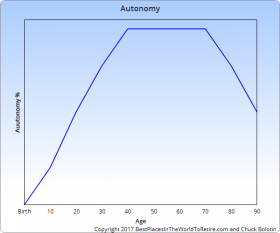 I’m using the word “autonomy” in a fairly strict sense to mean, “I can do what I want.” Generally, the more autonomy you have, the happier you are. When you were a child, you couldn’t do what you wanted, because (for very good reason) your parents put limits on your activities. This can make your “child self” unhappy.
I’m using the word “autonomy” in a fairly strict sense to mean, “I can do what I want.” Generally, the more autonomy you have, the happier you are. When you were a child, you couldn’t do what you wanted, because (for very good reason) your parents put limits on your activities. This can make your “child self” unhappy.Autonomy generally increases over our lifetimes. We may start with something like crossing the street by ourselves, then move on to our first bicycle, to our first car, then extending to deciding where we want to live, etc.; all increase our autonomy. Remember how happy reaching each of these milestones made you?
The reason the curve starts going down again at the end is if we get really old, our autonomy starts to be taken away again due to infirmities, which is not a happy time.
Obligations
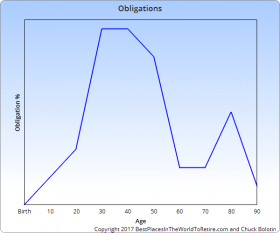 For most people, the greatest obligation they will have is to their children, which, while never completely ending, in most healthy circumstances, is less demanding over time, as we give our children the autonomy described above. The first hump shows our increasing obligations to our children, which then diminishes.
For most people, the greatest obligation they will have is to their children, which, while never completely ending, in most healthy circumstances, is less demanding over time, as we give our children the autonomy described above. The first hump shows our increasing obligations to our children, which then diminishes.As our parents get older, we start to have more obligations to them, because they start to lose their autonomy. This is the second, smaller hump.
Our other major obligations are to our significant other, but if he or she is generally in the same place on the other curves as we are, we can do things together, so it doesn’t feel like an obligation at all and doesn’t keep us from doing what we want.
Caring What Others Think of You
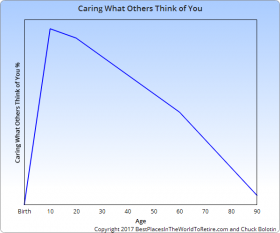 Generally, the more we care about what other people think of us, the less happy we are. Thankfully, this concern and resulting unhappiness generally peaks at about 8th grade, and slowly diminishes after that.
Generally, the more we care about what other people think of us, the less happy we are. Thankfully, this concern and resulting unhappiness generally peaks at about 8th grade, and slowly diminishes after that.As we get older, with wisdom and perspective (see below) and maybe some other factors not covered here, we tend to care less and less about what others think of us, which, when compared with that insecure 8th grader we once all were, is quite liberating and happiness generating.
Wisdom / Perspective
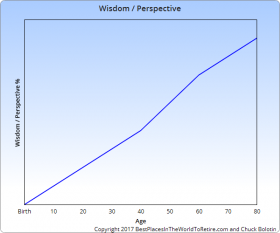 Hopefully, wisdom increases with age, and generally, the wiser someone is, the more content / satisfied / happier they are. (This may also tie into “Caring What Others Think of You, above.)
Hopefully, wisdom increases with age, and generally, the wiser someone is, the more content / satisfied / happier they are. (This may also tie into “Caring What Others Think of You, above.)Of course, we all know old people who are not wise and middle-aged or even younger people who are, but, as a general rule, and because living more years provides more opportunities for perspective, the Wisdom / Perspective Graph should continue to increase over our lifetimes, thereby making us progressively more at peace and happier.
Physical & Mental Abilities
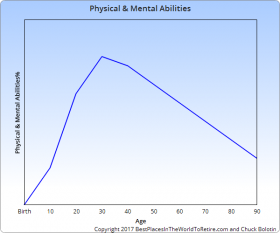 Unfortunately, for almost everyone, The Physical & Mental Abilities Curve, when viewed by itself, can be a bit depressing for anyone older than a college senior. For most people, for most activities, physical abilities peak in their 20s and mental abilities perhaps one or two decades later. After that (and please don’t shoot the messenger), we have to rely on the other curves like wisdom and perspective to make us happy. Sorry. It’s true.
Unfortunately, for almost everyone, The Physical & Mental Abilities Curve, when viewed by itself, can be a bit depressing for anyone older than a college senior. For most people, for most activities, physical abilities peak in their 20s and mental abilities perhaps one or two decades later. After that (and please don’t shoot the messenger), we have to rely on the other curves like wisdom and perspective to make us happy. Sorry. It’s true.Disposable Money
There are two components to “Disposable Money.” We’ll take “money” first.
Most people make progressively more money throughout their lifetimes, as they are rewarded for increased productivity, knowledge, etc. (Most 50 year olds make more than most 23 year olds.) However, for most people, at some point, this curve would start to go downward. For example, most 90 year olds make less than that 50-year-old we just envisioned.
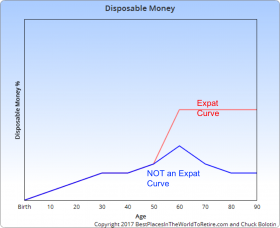 This frees us up to discuss the “Disposable” component of this curve. “Disposable” just means “money left over after paying for necessities.” The more disposable money we have, the happier and more relaxed we are.
This frees us up to discuss the “Disposable” component of this curve. “Disposable” just means “money left over after paying for necessities.” The more disposable money we have, the happier and more relaxed we are.The challenge then becomes: How do we have more disposable money? There are basically two ways: 1) make more money; or, 2) spend less money.
The “Eureka Moment” for me was when I realized that the joyful expats I kept meeting had figured out how to do the second alternative (spend less money), but while not giving up on the quality of their lifestyle. The reason is that they had moved to a location abroad that cost less but where they could enjoy the same lifestyle or better on that lower income than they would if they had not moved. (For just one example, see: “How Living in Mexico Can Give You a Lifestyle Upgrade.”)
That’s why I put two curves here—the “Not an Expat Curve,” in blue, is the typical trajectory of Disposable Money—it peaks in the peak earning years and then declines as we are no longer able to work, when we can no longer generate the same level of income. The “Expat Curve” is red, and departs from the more traditional blue curve at about age 50 or later, when the expat moves abroad and thereby lowers his or her cost of living. The difference between the red and blue curves can lead to a lot of happiness.
These expats were brilliant!
Free Time
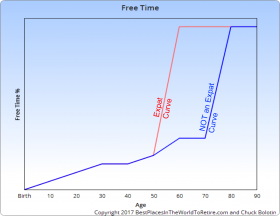 The Free Time Curve is very much tied into the Disposable Money Curve. If you have more than enough money to pay for the lifestyle you want, you have time to do things other than work. If you don’t have enough money to pay for the lifestyle you want and therefore, you have to work, you’re not going to have a lot of free time.
The Free Time Curve is very much tied into the Disposable Money Curve. If you have more than enough money to pay for the lifestyle you want, you have time to do things other than work. If you don’t have enough money to pay for the lifestyle you want and therefore, you have to work, you’re not going to have a lot of free time.
As described in the Disposable Money Curve, lots of these expats had figured out how to get more free time—simply move to a place where you can have the same lifestyle at less cost. Several had just quit their job and retired early, which, quite understandably, made lots of them very happy.
As above, the Not an Expat Curve is blue and the Expat Curve is red. The increase in free time for the expats compared with the non-expats in the center right of the chart comes from not working. Of course, after a certain age, most people can’t work, so the curves join up again in the later years, when pretty much everyone has lots of free time.
The Sweet Spot in Life Curve
Combining all these curves together into one, we can create the Sweet Spot in Life Curve for these expats, which explains my wife’s observation and our party companions’ comments.
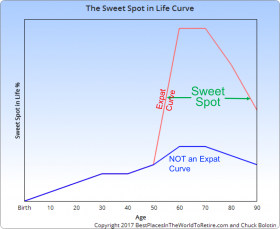 Mainly as a function of having more disposable income and more free time (the last two curves), these expats were happily basking on the red curve before both curves would converge later on, when issues like deteriorating health and / or abilities would tend to make their lives just like they would have been if they had not become expats. That’s the Sweet Spot, in green, which is exactly where these expats were, very happily.
Mainly as a function of having more disposable income and more free time (the last two curves), these expats were happily basking on the red curve before both curves would converge later on, when issues like deteriorating health and / or abilities would tend to make their lives just like they would have been if they had not become expats. That’s the Sweet Spot, in green, which is exactly where these expats were, very happily.
So, what do we do with this information?
My advice: take action. The Sweet Spot of Life Curve is not different for expats from non-expats forever. Don’t wait until you the Autonomy and Physical and Mental Abilities curves start turning down and you physically can’t do what you really want to regardless of where you live or how low your expenses. If you are retirement age, find a way to spend less money for the same lifestyle, just like these expats. If you do, all the other curves should be just about in the right place and there’s a very good chance that you can be as happy as those expats we met at our party—right in the Sweet Spot.
Enjoy!
 The Free Time Curve is very much tied into the Disposable Money Curve. If you have more than enough money to pay for the lifestyle you want, you have time to do things other than work. If you don’t have enough money to pay for the lifestyle you want and therefore, you have to work, you’re not going to have a lot of free time.
The Free Time Curve is very much tied into the Disposable Money Curve. If you have more than enough money to pay for the lifestyle you want, you have time to do things other than work. If you don’t have enough money to pay for the lifestyle you want and therefore, you have to work, you’re not going to have a lot of free time.As described in the Disposable Money Curve, lots of these expats had figured out how to get more free time—simply move to a place where you can have the same lifestyle at less cost. Several had just quit their job and retired early, which, quite understandably, made lots of them very happy.
As above, the Not an Expat Curve is blue and the Expat Curve is red. The increase in free time for the expats compared with the non-expats in the center right of the chart comes from not working. Of course, after a certain age, most people can’t work, so the curves join up again in the later years, when pretty much everyone has lots of free time.
The Sweet Spot in Life Curve
Combining all these curves together into one, we can create the Sweet Spot in Life Curve for these expats, which explains my wife’s observation and our party companions’ comments.
 Mainly as a function of having more disposable income and more free time (the last two curves), these expats were happily basking on the red curve before both curves would converge later on, when issues like deteriorating health and / or abilities would tend to make their lives just like they would have been if they had not become expats. That’s the Sweet Spot, in green, which is exactly where these expats were, very happily.
Mainly as a function of having more disposable income and more free time (the last two curves), these expats were happily basking on the red curve before both curves would converge later on, when issues like deteriorating health and / or abilities would tend to make their lives just like they would have been if they had not become expats. That’s the Sweet Spot, in green, which is exactly where these expats were, very happily.So, what do we do with this information?
My advice: take action. The Sweet Spot of Life Curve is not different for expats from non-expats forever. Don’t wait until you the Autonomy and Physical and Mental Abilities curves start turning down and you physically can’t do what you really want to regardless of where you live or how low your expenses. If you are retirement age, find a way to spend less money for the same lifestyle, just like these expats. If you do, all the other curves should be just about in the right place and there’s a very good chance that you can be as happy as those expats we met at our party—right in the Sweet Spot.
Enjoy!
To see hundreds of questions answered by expats already living in Mexico, click here.
To see hundreds of questions answered by expats already living in Mexico, Panama, Belize, Nicaragua and Portugal, go here and navigate to the place you're most interested in.
Sign up for the Best Places in the World to Retire newsletter. To see additional additional pictures and videos not in the stories, follow us on Facebook. To see more videos of the trip, see our YouTube channel.
Want online, interactive help finding the best place abroad for you? Try the Location Advisor.
To download free research studies conducted with over 1,000 expats currently living in Mexico, click here.
Download the free eBook of all the stories below, "Our Year on the Road & Living in Mexico-- Adventures, Challenges, Triumphs, Lessons Learned"
Links to Mexico Road Trip stories:
Editor’s note: you may freely reprint the article above, provided you put this at the beginning or end:
Content provided by Best Places in the World to Retire, which provides credible answers to questions about moving abroad, expat stories, and a location advisor to help you find the perfect place for you.
Content provided by Best Places in the World to Retire, which provides credible answers to questions about moving abroad, expat stories, and a location advisor to help you find the perfect place for you.



.png)